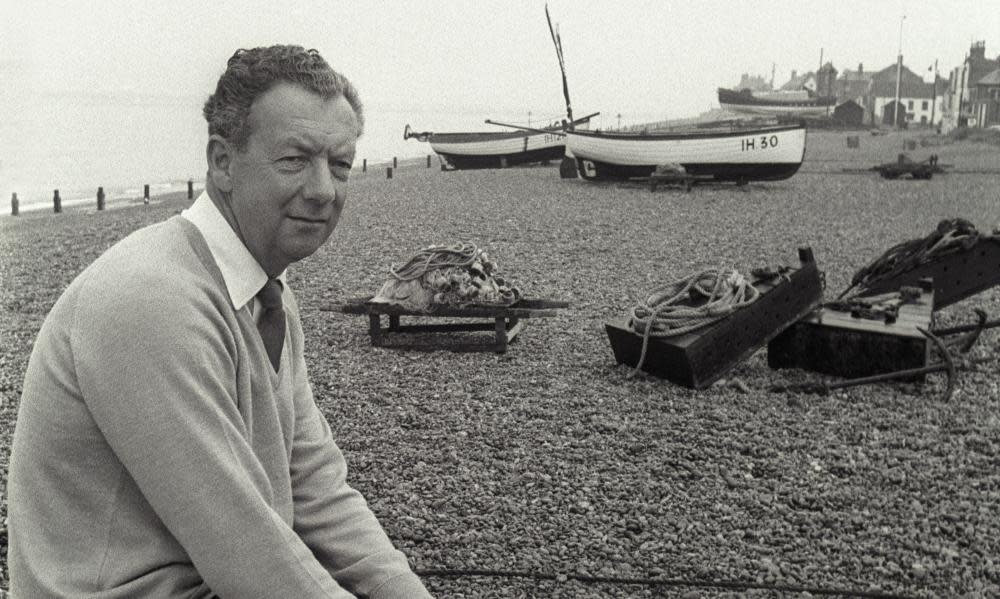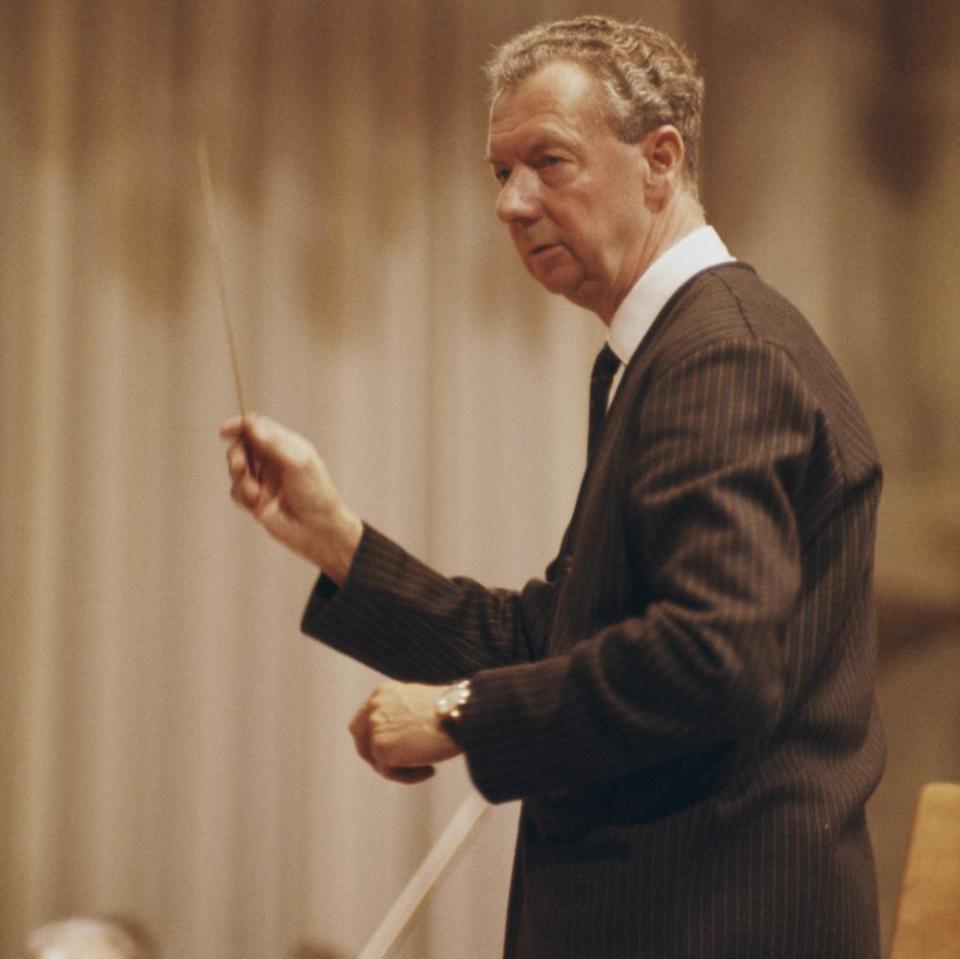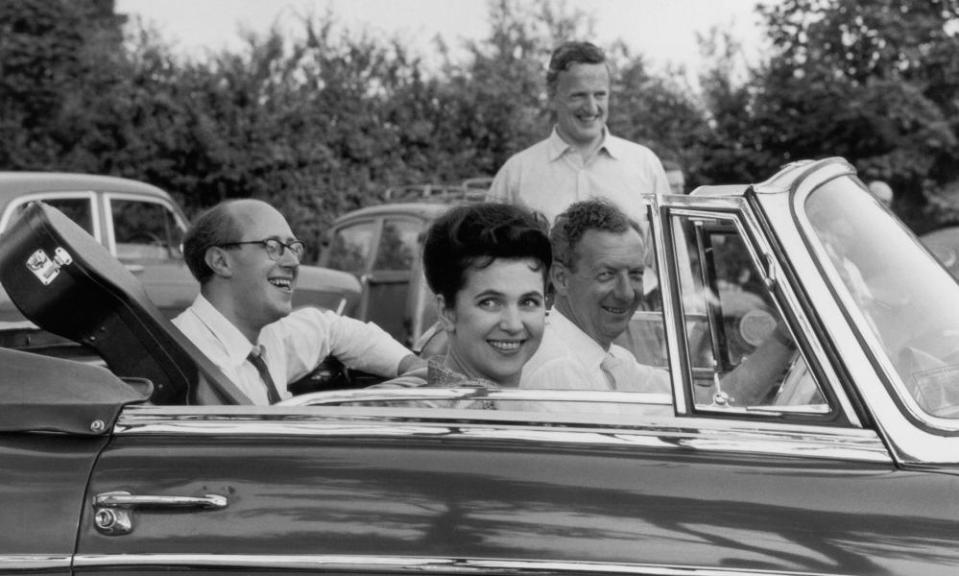Britten: where to start with his music

Starting with Peter Grimes in 1945, Benjamin Britten (1913-1976) completely changed the shape of opera in the UK, and opera in English. He brought the same level of intensity to works for huge forces as to his smallest-scale chamber operas, changing perceptions of what the genre could achieve, and at least half a dozen of his works are now mainstays of the international opera scene. He had the ability to compose for amateurs and young performers without writing down to them – a composer’s job, he said, was “to be useful”. Establishing the Aldeburgh festival and the concert hall at Snape Maltings, he transformed a pocket of Suffolk into one of the UK’s most important musical centres.
The music you might recognise
Not so long ago, every schoolchild knew Britten’s Young Person’s Guide to the Orchestra, a tour of the concert platform in the form of variations on a theme by Purcell, often guided by a narrator – on recordings you can hear Sean Connery or, if you’d rather, Dame Edna Everage. Wes Anderson was inspired by Britten’s music to make his 2012 film Moonrise Kingdom, and he threads it through the soundtrack. If you have heard a British folk song with piano accompaniment, chances are it was in one of the arrangements Britten made for his partner, the tenor Peter Pears; while you might not knowingly have stumbled across any of the original music he wrote for Pears, the style of it – in his Serenade for Tenor, Horn and Strings, for example – is distinctive enough to explain why it had the dubious honour of being parodied, brilliantly, by Dudley Moore.
His life …
Britten was born in 1913 in Lowestoft on the Suffolk coast, and grew up able to watch the North Sea from his windows. Aged six, he was already writing music. Aged 10 he was taken to a concert in Norwich at which he heard Frank Bridge’s tone poem The Sea, conducted by its composer; as he later described it, he was “knocked sideways”. Three years later he met Bridge, who took him under his wing as a private composition pupil, and remained a greater influence than any of the teachers Britten would encounter at the Royal College of Music. His 1937 Variations on a Theme of Frank Bridge is an affectionate homage.
After graduating Britten worked for the Film Unit of the General Post Office, writing music for public service films. One of his colleagues was WH Auden – they collaborated on the short 1936 film The Night Mail and others – and the poet became another major influence, not only artistically but personally. Britten’s lifelong pacifist views were already formed, but now, in a country many feared was headed towards war, he found himself surrounded by articulate voices of dissent, with new friends including the writers Christopher Isherwood and Stephen Spender. In this company he also began to accept what he had come to recognise as his homosexuality. Auden would go on to provide the texts for several of Britten’s early works, including the four Cabaret Songs (which include a setting of Funeral Blues, the poem John Hannah recites in Four Weddings and a Funeral – here it is, as sung by Greta Thunberg’s mum), the choral Hymn to St Cecilia and his first opera, Paul Bunyan. Auden also pointed Britten to the 19th-century French poet Arthur Rimbaud, whose words he set in the dreamy, glittering Les Illuminations.
In 1938 Auden and Isherwood left for the US. Britten – aged 25, with a growing reputation as a composer and pianist, yet feeling stifled in London and despondent at the political situation in Europe – followed them a few months later. His companion was a friend he had met a couple of years earlier: the singer Peter Pears. The two became romantically involved soon after they arrived in the US, and the relationship was to last for the rest of Britten’s life. Many of his most enduring works were written with the distinctive sound of Pears’s high, airy tenor in mind, from the Seven Sonnets of Michelangelo of 1940 to his final opera, 1973’s Death in Venice.
… and times
Britten’s three years in the US were productive: he wrote a Violin Concerto, the first of his three String Quartets and the Sinfonia da Requiem, an impassioned anti-war work that is also a heartfelt memorial to his parents. He made some important contacts – and, again through Auden, some stimulating friends. For a few months he and Pears lived in Brooklyn in what can only be described as a party house, with fellow tenants including Auden, the writer Carson McCullers and Gypsy Rose Lee (who sublet her room to some circus workers and their chimpanzee), and with a constant stream of arty guests such as Salvador Dalí and Anaïs Nin.
Back in the UK, public opinion of Britten, Auden and others like them had deteriorated. Bombs were falling on British cities, yet here were young men who had travelled halfway across the world to avoid being called up; what is more, Britten and Pears were openly living as a couple (homosexual acts would not be decriminalised in the UK for another 25 years). Even the editor of the Musical Times was moved to suggest that Britten would find it hard to deal with “the consciousness of having saved one’s art and skin at the cost of failure to do one’s duty”. In the end, duty was less a factor than homesickness and disillusionment with the American Dream, and he and Pears returned home. Back in London, they registered as conscientious objectors, and for the rest of the war they travelled the UK giving recitals in canteens and village halls.

Britten’s homesickness in the US had been sparked partly by reading the Suffolk poet George Crabbe, and since then his second opera had been brewing in his mind. Peter Grimes, based on Crabbe’s 1810 poem The Borough, is the story of a fisherman who has already had one child apprentice die in his boat and who is hounded to his death when the villagers suspect him of mistreating the next one. A few weeks after VE Day it opened at Sadler’s Wells, with Pears in the title role.
Why his music still matters
Peter Grimes put British opera on the international stage. Within three years it had been staged in 15 cities including New York, Milan and Berlin. His next two operas, The Rape of Lucretia and the Suffolk-set Albert Herring, written for touring companies, honed his skill at composing for small forces, something he perfected in his 1954 retelling of Henry James’s ghost story The Turn of the Screw. The role of the boy Miles in that opera was written for David Hemmings, later the star of films including Blow-Up, and one of several boys with whom Britten would develop a close friendship that on the composer’s side bordered on infatuation; Hemmings and others have emphasised that Britten never behaved inappropriately towards them.
There were big Royal Opera commissions, too: Billy Budd (1951), which brought Britten together with EM Forster, and Gloriana, which flopped in 1953 in front of an audience of grandees who, expecting something suitably glossy in honour of Elizabeth II’s coronation, were nonplussed to be presented instead with a warts-and-all portrait of an ageing Elizabeth I.
The feeling was mutual: even while Britten mingled easily in London society and rubbed shoulders with royalty, he always felt like an outsider: “I would have been a court composer,” he once remarked to his fellow composer Michael Tippett, “but for my pacifism and homosexuality.” He and Pears settled instead in Aldeburgh on the Suffolk coast, and in 1948 established an annual music festival there. New works by Britten were premiered at the festival most years, including Noyes Fludde, involving a huge cast of schoolchildren, and his three Church Parables. Like the five Canticles, these works are not devotional but are fired with an oblique kind of mysticism, presenting a God who is easy to approach but impossible to comprehend.

A tour to Asia in 1956 brought the sound of the Balinese gamelan into his works, something you can hear in his ballet The Prince of the Pagodas and his sparkling operatic adaptation of A Midsummer Night’s Dream, another work premiered at Aldeburgh. In 1967 the festival got the venue it deserved with the conversion of the Maltings in nearby Snape into a concert hall. By now it was a significant international event drawing performers of the stature of the Russian cellist Mstislav Rostropovich – who inspired Britten to a burst of writing for his instrument including the Cello Symphony – and his wife, the soprano Galina Vishnevskaya.
Britten greatly valued his friendship with Rostropovich, forged across a gaping political divide. Even though he had not seen active service, he had witnessed some of war’s horrors – he and the violinist Yehudi Menuhin gave a recital in the concentration camp at Belsen only a few weeks after its liberation. He wrote the War Requiem for the opening of the new Coventry Cathedral in 1962. Juxtaposing poetry by Wilfred Owen with the Latin mass for the dead, it remains one of the most powerful pacificist works of our time.
Great performers
There’s an old adage that composers aren’t the best interpreters of their own work, but Britten is an exception – the recordings he conducted are often excellent. Steuart Bedford’s performances have authority and authenticity thanks to his long working relationship with Britten, and Edward Gardner is building an impressive catalogue of recordings. Pears’s distinctive tone is ingrained in much of the vocal music, but tenors including Anthony Rolfe Johnson, Robert Tear, Philip Langridge, Ian Bostridge and Mark Padmore have all successfully put their stamp on it – and it’s Stuart Skelton who has current ownership of the role of Peter Grimes.


